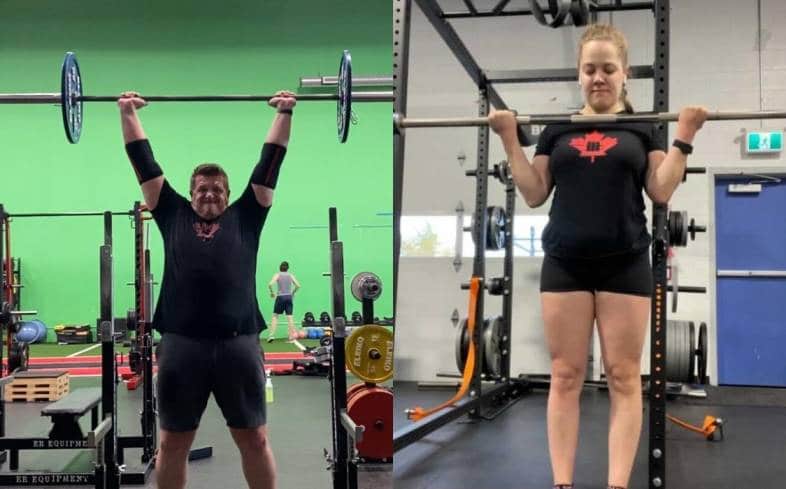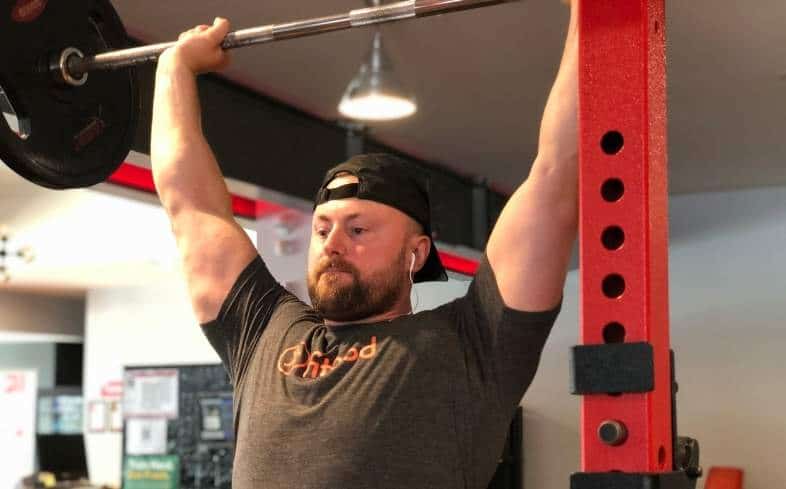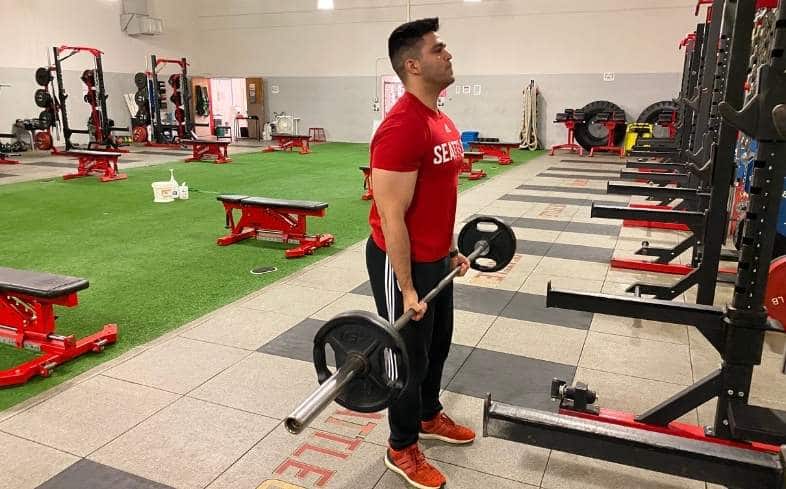Can You Train Shoulders And Biceps On The Same Day? | PowerliftingTechnique.com (original) (raw)

While you can certainly train shoulders and biceps on different days, as that’s how many “bro splits” are structured, how effective is training these muscle groups on the same day?
Can you train your shoulders and biceps on the same day? Yes, training shoulders and biceps together can be an effective way to structure your workouts, especially because some bicep exercises involve parts of the shoulder and vice versa. Also, training shoulders and biceps on the same day can fit most “push-pull” training splits, and is ideal if you work out 4 days per week.
I don’t necessarily think that training your shoulders and biceps on the same day or different days is better than the other. It simply comes down to your training goals, area of weakness, how much time you have to train, and the equipment you have available.
However, if you do want to train your shoulders and biceps on the same day, there are several considerations you need to be aware of before starting, which we’ll discuss below.
Table of Contents
Toggle
- Is Training Shoulders And Biceps On The Same Day Effective?
- Want to get advice on programming, technique, or competing? Speak with one of our coaches.
- 3 Benefits Of Working Out Shoulders And Biceps Together
- What Should You Consider When Training Shoulders and Biceps Together?
- How Should You Program Your Shoulders And Bicep Workouts? (3 Ways)
- What To Read Next
- About The Author
Is Training Shoulders And Biceps On The Same Day Effective?

Training biceps and shoulders together are not only effective, but it’s a logical approach to get more done in a week. Most lifters will combine muscle groups into a single workout, whether they train a little bit of everything in a full-body workout, or focus on one area, like legs or arms.
One of the biggest reasons this approach is effective is that it allows you to get more done in a single workout so that you have time later that week to train these muscles a second time, which research has shown is important for hypertrophy.
The one-piece to consider here is your goals:
If you are focused on the maximal strength of your muscles, you’ll want to perform those exercises first.
For the same reason a powerlifter will train their maximal effort squat, bench press, or deadlift early in the workout, you’ll want to use your energy and work capacity to train shoulders or biceps.
Research supports that you make better strength gains on lifts performed early in the workout before fatigue sets in.
So, if you care more about shoulder strength, do those exercises first, then move on to the biceps. Otherwise, you shouldn’t need to think too hard about what order to complete your workout in.

Want to get advice on programming, technique, or competing? Speak with one of our coaches.
3 Benefits Of Working Out Shoulders And Biceps Together

There are three benefits of training shoulders and biceps together:
- Training them together is time efficient
- You can train these muscle groups twice per week
- Your work capacity can improve
Training Them Together Is Time Efficient
If you’ve only got 60 minutes to train each day, you can get more bang for your buck by training muscles in pairs or groups, rather than spending the full hour on a single muscle.
While there’s nothing wrong with training a single muscle a day, it does require that you train more days a week (usually 6-7) to cover your whole body.
When you combine muscles into groups or pairs, you can exercise 3-5x a week instead of daily.
Secondly, when you incorporate a second muscle, you can train that muscle while the other one rests, reducing the amount of time you need to sit idle between sets and recover.
This can be accomplished even more efficiently with supersets, which are the practice of taking two different exercises for two different muscles, and training in alternating sets. In our example, you could perform a set of DB biceps curls, then immediately perform a set of DB lateral raises without resting (or with only short rest) in between.
By incorporating supersets, you get more done in the same amount of time.
It Enables You to Train Muscle Groups at Least Twice a Week
There is a strong correlation between hypertrophy (gaining muscle) and training muscles twice per week. Combining biceps and shoulders allows you to train them again later that week.
Imagine having your shoulders/biceps work combined in a push-pull workout, shoulders being your “pushing muscles”, and biceps being your “pulling muscles”.
The next day you could train legs, and 1-2 days later your shoulders and biceps are recovered and ready to train again in a dedicated shoulders/biceps day.
Remember, your shoulders and biceps get a lot of activation while performing chest and back exercises, so if you didn’t want to dedicate another full day to shoulders and biceps, you could still get activation by performing exercises like bench press, dips, pull-ups, and underhand barbell rows.
The lifter that only trains biceps or shoulders on their own day would have to wait a full week to get back to them without skipping some other muscle group entirely.
Your Work Capacity Can Improve
Not only do the supersets we discussed earlier make your time more efficient, these can also improve your work capacity.
Your work capacity is simply your endurance for a workout – how much volume is your body trained to perform in a given day or given workout? When training for a marathon, the runner’s work capacity increases as their body adapts to longer runs.
Similarly, the resistance athlete can endure longer workouts, shorter rest, and more volume by increasing their work capacity.
Because you allow yourself short rest between alternating exercises in a superset, you improve not only your muscular size and strength, but your own work capacity. The better your work capacity, the more stress you can induce on your muscles, and the better results you’ll get.
What Should You Consider When Training Shoulders and Biceps Together?

While there isn’t much risk of training to combine shoulders and biceps in the same day, there are certainly a few things you should consider to be sure you are getting the most of it.
Consider Your Weak Points
If you feel your biceps need attention, and you aren’t training them consistently, this could be a great reason to combine them with your shoulder work.
On the other hand, if your shoulders are your area of focus, they need more attention, you can easily cut out some of your bicep day and replace it with shoulder work to get that extra volume you need to get them bigger and stronger.
Whatever your current weakness, consider it when deciding how to alter your workouts.
For me, I know shoulders have always been a weak point from both a strength and aesthetics perspective. I started to make progress when I had 1 full day dedicated to shoulders, and then a second day where I did some additional shoulder work after my bicep day.
On the dedicated shoulder day I mostly did compound movements like military press and dumbbell press. On the bicep day, I tacked on some lateral raises, front raises, and seated rope face pulls.
Consider the Equipment You Have Access To
This is especially important when considering supersets.
If you train in a commercial gym during peak times, it’s unlikely you’ll be able to jump back and forth between using a weight stack for cable curls, walk over to a bench and perform incline bench press reps, and still have your cable stack unoccupied when you return.
Think through the equipment you have access to, where it’s located in the gym, and plan supersets you can do without leaving your current station, or at least having to go too far away.
Consider How Much Time You Have To Train
If you have more time, this might allow you to warm up your shoulders and then train them for strength with overhead presses and other compound exercises. You can spend more time resting between sets before moving into supersets and incorporating your biceps.
On the other hand, if you’re pressed for time, you might structure a combined biceps/shoulder day to start with supersets and avoid long rest periods the entire time.
Consider How Often You Can Train
Lastly, think about how often you train in general, and how often you train biceps and shoulders.
If you have a chance to train them again in the week, try making each workout a little different. Maybe one is focused on supersets, and the other is more focused on heavier reps for strength.
If it’s your only day of the week to train arms at all, try to incorporate as much variety as you can into a single workout, knowing it’s your only chance that week to get it all done.
How Should You Program Your Shoulders And Bicep Workouts? (3 Ways)

As you think about this muscle pairing, there are three ways to prioritize it – shoulder priority, biceps priority, or a balanced priority.
Weak Shoulders – Train Shoulders First
These workouts will prioritize your shoulders, and incorporate biceps as well.
- Standing BB Overhead Press – 5 sets of 5 reps
- Seated DB Overhead Press – 4 sets of 6 reps
- Superset – DB Lateral Raise and Seated DB Curls – 4 sets of 10
- Superset – BB Upright Row and Standing BB Curl – 4 sets of 10
- Superset – Plate Front Raise and EZ Bar Cable Curl – 4 sets of 10
Weak Biceps – Train Biceps First
These workouts will prioritize biceps while incorporating shoulders
- Barbell Biceps Curl – 5 sets of 6
- Negative Biceps Curl – 4 sets of 5, 5 second negative tempo
- Superset – Dumbbell Hammer Curls and Arnold Presses – 4 sets of 10
- Superset – Seated DB Curls and Seated DB Front Raise – 4 sets of 10
- Superset – Preacher EZ Bar Curl and BB Upright Rows – 4 sets of 10
Balanced Shoulders/Biceps – Alternate Between Muscle Groups
If your focus on the two muscles is equal, you can alternate between muscle groups, or attack them one at a time.
Either approach is good, but the alternating workout will generally allow for shorter rest time between sets, while the sequential workout can potentially provide a bigger pump and higher intensity on each muscle, if you do it right.
Alternating Workout
- Biceps Curl Machine – 4 sets of 12 reps
- Lateral Raise Machine – 4 sets of 12 reps
- Cable Straight Bar Curl – 4 sets of 10
- Cable Upright Row – 4 sets of 10
- Barbell Curl – 4 sets of 8
- Barbell Overhead Press – 4 sets of 8
- Dumbbell Hammer Curl – 4 sets of 10
- Dumbbell Lateral Raise – 4 sets of 10
Sequential Workout
- Biceps Curl Machine – 4 sets of 12 reps
- Cable Straight Bar Curl – 4 sets of 10
- Barbell Curl – 4 sets of 8
- Dumbbell Hammer Curl – 4 sets of 10
- Lateral Raise Machine – 4 sets of 12 reps
- Cable Upright Row – 4 sets of 10
- Barbell Overhead Press – 4 sets of 8
- Dumbbell Lateral Raise – 4 sets of 10
What To Read Next
- What Else Should I Do On Chest Day?
- What Else Should I Do On Biceps Day?
- What Else Should I Do On Shoulder Day?
- What Else Should I Do On Deadlift Day?
- Can You Workout Shoulders And Back Together?
- Can You Work Out Back And Chest On Same Day?
- Is It Better To Do Bicep Curls One At A Time?
- Is It Okay To Do Bicep Curls Every Day?
- Can You Train Back And Legs On The Same Day?
- Can You Train Legs and Shoulders on the Same Day?
- Can You Train Chest And Legs On The Same Day?
- Can You Train Legs And Arms On The Same Day?
- 9 Best Preacher Curl Alternatives (With Pictures)
- Can You Train Biceps And Chest On The Same Day?
- Is Arm Day A Waste Of Time? Pros & Cons (Science-Backed)
About The Author
Adam Gardner is a proud resident of Utah, where he lives with his wife and two kids. He has been competing in powerlifting since 2016 in both the USPA and the APF. For the past three years, he and his wife, Merrili, have coached beginning lifters to learn the fundamentals of powerlifting and compete in their first powerlifting competitions.